
Okinawa currently sends 8 elected members to the Diet of Japan, 6 to the House of Representatives and 2 to the House of Councillors.

Okinawa currently sends 8 elected members to the Diet of Japan, 6 to the House of Representatives and 2 to the House of Councillors.
The current House of Representatives Okinawa delegation consists of 2 members of the LDP, 1 JCP, 1 SDP, 1 LP and 1 NIK.
| District | Representative | Party | Incumbency |
|---|---|---|---|
| 1st | Seiken Akamine (C-Naha) | JCP | 15 December 2014 – present |
| 2nd | Kunio Arakaki (SD-Ginowan) | SDP | 3 November 2021 – present |
| 3rd | Aiko Shimajiri (LD-Okinawa City) | LDP | 3 November 2021 – present |
| 4th | Kōsaburō Nishime (LD-Haebaru) | LDP | 1 November 2017 – present |
Okinawa Prefecture is part of the Kyushu proportional representation block. In the current Diet, there are two Representatives from Okinawa elected through the Kyushu PR block.
| Representative(s) | Party | District contested | Incumbency |
|---|---|---|---|
 Kōnosuke Kokuba (LD-Naha) Kōnosuke Kokuba (LD-Naha) | LDP | Okinawa-1st | 15 December 2014 – present |
 Masahisa Miyazaki (LD-Ginowan) Masahisa Miyazaki (LD-Ginowan) | LDP | Okinawa-2nd | 22 November 2018 – present |
The current House of Councillors Okinawa delegation consists of 2 independent members. Both are members of the Okinawa Whirlwind caucus in the House. The members are elected from the Okinawa at-large district.
| Party | Councillors | Term ends | Incumbency |
|---|---|---|---|
| OW |  Yōichi Iha Yōichi Iha | 2022 | 26 July 2016 – present |
| Tetsuo Takara | 2025 | 29 July 2019 – present | |

The National Diet is the national legislature of Japan. It is composed of a lower house, called the House of Representatives, and an upper house, the House of Councillors. Both houses are directly elected under a parallel voting system. In addition to passing laws, the Diet is formally responsible for nominating the Prime Minister. The Diet was first established as the Imperial Diet in 1890 under the Meiji Constitution, and took its current form in 1947 upon the adoption of the post-war constitution. Both houses meet in the National Diet Building in Nagatachō, Chiyoda, Tokyo.

Yamaguchi Prefecture is a prefecture of Japan located in the Chūgoku region of Honshu. Yamaguchi Prefecture has a population of 1,377,631 and has a geographic area of 6,112 km2. Yamaguchi Prefecture borders Shimane Prefecture to the north and Hiroshima Prefecture to the northeast.



Nagasaki Prefecture is a prefecture of Japan located on the island of Kyūshū. Nagasaki Prefecture has a population of 1,314,078 and has a geographic area of 4,130 km2. Nagasaki Prefecture borders Saga Prefecture to the northeast.

The Japanese political process has two types of elections.
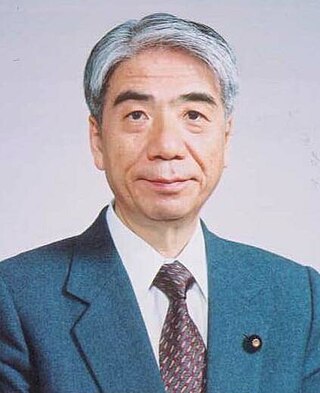
Hidehisa Otsuji is a Japanese politician who serves as the President of the House of Councillors since August 2022. A member of the Liberal Democratic Party, he has been a member of the House of Councillors since 1989, serving as Vice President of the House of Councillors from 2010 to 2012 and as Minister of Health, Labour, and Welfare from 2004 to 2005.
The Okinawa at-large district is a constituency of the House of Councillors in the Diet of Japan. It consists of the entire prefecture of Okinawa and was created in 1970 following the agreement between US president Richard Nixon and prime minister Eisaku Satō on restoration of Japanese sovereignty over the Ryūkyū islands. Okinawa is represented by two Councillors electing one every three years.
Politics of Nagasaki, as in all prefectures of Japan, takes place in the framework of local autonomy that is guaranteed by the Constitution and laid out in the Local Autonomy Law. The administration is headed by a governor directly elected by the people every four years in first-past-the-post elections. Legislation, the budget and the approval of personnel appointments, including the vice governor, are handled by the prefectural assembly that is directly elected by the people every four years by single-non transferable vote.
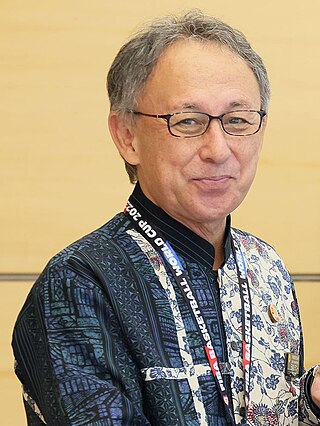
Denny Tamaki is a Japanese politician and the current Governor of Okinawa Prefecture since August 2018.
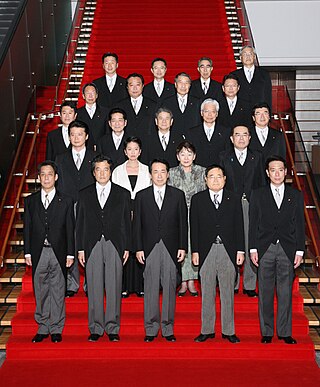
The Kan Cabinet was the cabinet governing Japan from June 2010 to September 2011 under the leadership of Prime Minister Naoto Kan, who came into power after winning the DPJ leadership election in June 2010. The Kan Cabinet oversaw the response to the aftermath of the 2011 Tōhoku earthquake and tsunami and the scaling-down of Japan's nuclear energy dependence following the nuclear disaster at TEPCO's Fukushima Daiichi nuclear power plant.

Hokkaido currently sends 17 elected members to the Diet of Japan, 12 to the House of Representatives and 5 to the House of Councillors. The prefecture will send 6 Councillors starting 2019.

Tokyo currently sends 53 elected members to the Diet of Japan, 42 to the House of Representatives and 11 to the House of Councillors.
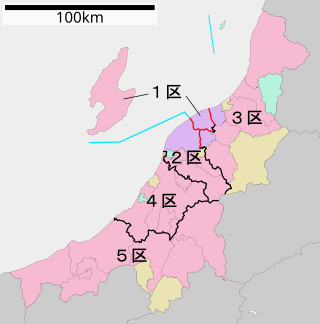
Niigata currently sends 12 elected members to the Diet of Japan, 10 to the House of Representatives and 2 to the House of Councillors. The prefecture lost 1 Councillor due to reapportionment in 2019.

House of Councillors elections were held in Japan on 21 July 2019 to elect 124 of the 245 members of the House of Councillors, the upper house of the then 710-member bicameral National Diet, for a term of six years.

Aichi Prefecture currently sends 36 elected members to the Diet of Japan, 29 to the House of Representatives and 7 to the House of Councillors.
Tetsumi Takara is a Japanese politician currently serving as a member of the National Diet in the House of Councillors. He was elected on July 27, 2019, representing the Okinawa at-large district which encompasses the entirety of Okinawa Prefecture.
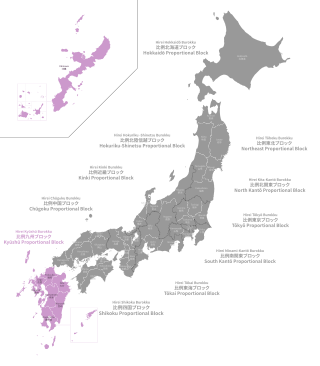
The Kyushu proportional representation block is one of eleven proportional representation (PR) blocks for the House of Representatives in the Diet of Japan. It consists of the Kyushu region and Okinawa prefecture, and consists of the prefectures of Fukuoka, Saga, Nagasaki, Kumamoto, Ōita, Miyazaki, Kagoshima, and Okinawa. Proportional voting blocks were first introduced in the 1996 General Election. The block elects 21 members to the House of Representatives.